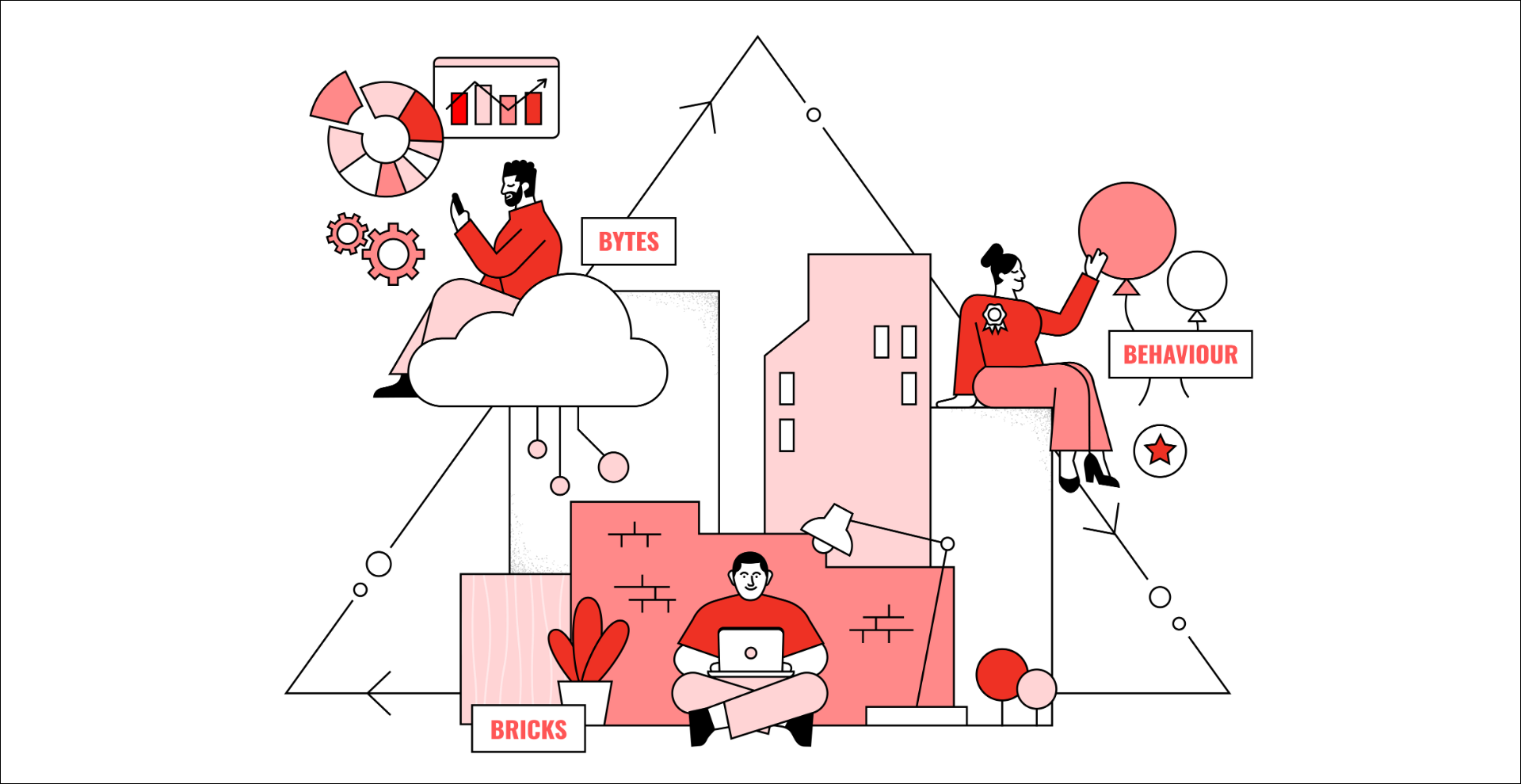A well-designed workplace strategy involves balancing three main elements: the physical space (bricks), the technology that supports team communication and work (bytes), and the culture (behaviours) that tie them all together.
With a widespread shift to remote and hybrid workplaces, the previous tendency to focus on physical design is shifting. A shared built environment (the office) loses overwhelming dominance in the process of building workplace strategy because teams rely on each other's behaviours more significantly and profoundly.
This article explores these three elements, the reasons to shift from the old way (bricks-first) to the better way (behaviours-first), and common questions we get to help you get started with a behaviours-first approach to your hybrid work strategy.
 KEY TAKEAWAYS
KEY TAKEAWAYS
- Workplace transformations tend to focus primarily on on-time delivery of the built environment, with change management measurement being underestimated.
- For Hybrid workplace transformations, the built environment will no longer be employees' primary source of meaning and belonging. A ‘behaviours first’ approach will be needed to deliver success.
- Even in a hybrid setting, the office is no longer the nucleus of work; work is no longer solely a physical destination.
3 ELEMENTS AT PLAY:
BRICKS, BYTES, AND BEHAVIOURS
Workplace strategies are a mix of these three fundamental elements. However, hybrid working requires that we shift our focus away from the office as the centralised shared space. This shift gives way to a well-balanced approach to workplace strategy with these three key elements:
- Built Environment ('Bricks'): The physical space where work takes place
- Digital Platform ('Bytes'): The technological infrastructure that supports communication and collaboration
- Behavioural Way of Working ('Behaviours'): The cultural and behavioural aspects that guide how employees interact and engage
DEVELOP A WORKPLACE STRATEGY IN 8 STEPS
Let’s look at the guiding principles of a workplace strategy. This is the blueprint that aligns your organisation's goals with its operational structure to enhance productivity and employee engagement.
Here's how to develop an effective workplace strategy:
- Define the Goals: Begin by clarifying overarching objectives. What do you want to achieve through your workplace strategy? Whether it's boosting collaboration, accommodating remote work, or fostering innovation, clear goals provide the foundation.
- Gather Data: Conduct a thorough analysis of your current workplace dynamics. For example, A utilisation study on employee work patterns, preferences and communication methods is a powerful aid.
- Engage Stakeholders:
Involve key stakeholders, including leadership, department heads, and employees, in the strategy development process. This input is invaluable in shaping a strategy that resonates across teams and individuals. - Create a 'Behaviours First' Approach:
If hybrid work is part of the equation, prioritise a 'behaviours-first' approach. Define the desired behaviours around how employees collaborate, communicate, and manage their time. - Design the Built Environment:
Work with experts fluent in crafting a physical workspace that supports the identified behaviours and work patterns. This will include multiple environments - open spaces for collaboration, quiet zones for focused work, and adaptable layouts for flexibility. The design should reflect and reinforce your organisation's culture and values. - Leverage Digital Tools:
Select and implement digital platforms that facilitate seamless communication, information sharing, and remote collaboration. Ensure these tools align with your strategy's goals and enable the desired behaviours. - Build Change Management Plans:
Address the behavioural aspect of your strategy with a robust change management plan. Educate employees about the new approach, train them on digital tools, and create a supportive environment for adapting. Identify change champions who can also help support the process. - Measure and Adjust: Establish key performance indicators (KPIs) to evaluate the success of your strategy. Monitor metrics such as employee engagement, productivity, and collaboration. Regularly review the plan and adjust based on feedback and data analysis.
In the era of hybrid workplaces, the physical environment ('bricks') will no longer serve as employees' primary source of belonging and meaning. This shift necessitates a 'behaviours first' approach to achieve successful transformation.
A holistic workplace strategy seamlessly integrates the 'bricks,' 'bytes,' and 'behaviours.'
Our Country Lead in Sweden Jonas Thelandersson explains this using the example of a three legged stool:
"In New Ways of Working with a shared physical environment and high choice, there are three main factors that make the journey successful; leadership modelling the change, the physical space that's tailored to the goals, and behavioural support to match the ambition of the desired change.
You cannot sit on a stool with just one leg, two is wobbly and dangerous even! It's three legs that create stability. Still, behavioural support needs the most focus."
Jonas Thelandersson
Veldhoen + Company | Senior Consultant


